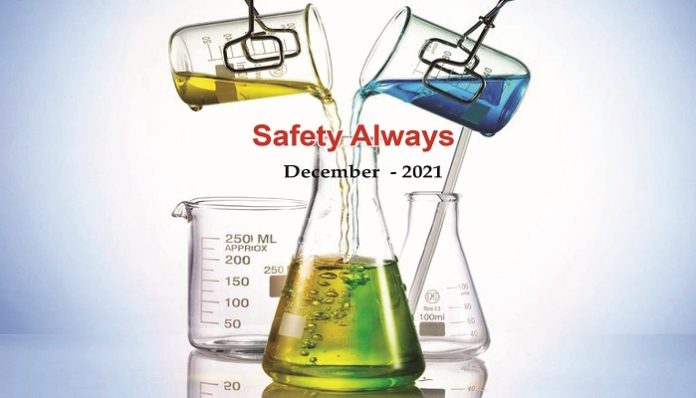Safety culture has to be painstakingly built and assiduously nurtured. The recent spate of accidents in the chemical industry probably points to a breakdown in the safety culture. Complacence and overconfidence are arch enemies of safety. Digital tools of Industry 4.0 can be leveraged to enhance safety in multiple ways.
After a significant downtrend in the number of accidents and fatalities in the chemical industry in the years leading up to the pandemic, 2020 and 2021 have witnessed an unfortunate reversal. A major explosion in a chemical plant in Leverkusen, Germany, that killed seven people in July 2021, was eerily reminiscent of the notorious Seveso incident of 1976 due to the possible release of dioxin. A chemical leak in a Texas plant in July 2021 that killed two and injured thirty, is being regarded as the worst chemical accident since 2019. India witnessed a sudden spurt in accidents following the resumption of industrial activities after the lockdown restrictions were eased in mid-2020. 118 fatalities were reported in 64 accidents between May and December 2020. This unfortunate turn of events has extended into 2021 with 117 fatalities and 142 injuries reported from 52 industrial accidents between January and June. Even as this article was being drafted, a major fire broke out in Indian Oil refinery, killing three and injured more than 40. Poor safety awareness, lax implementation of safety protocols, inadequate risk assessment, large number of poorly trained contract workers and breakdown of emergency response systems are responsible for this setback.
Seveso Directive
On 10th July 1976, Dioxin, an extremely toxic chemical was released into the atmosphere from a reactor in a chemical plant on the Italian town of Seveso. Over the next few weeks, several people took ill and a large swathe of area around the plant to the extent of 17 square km was declared contaminated. Following this incident, the European Commission developed a legislation that is now famously known as the Seveso Directive. Formally adopted in 1982, the Seveso Directive soon became the gold standard for policy and legislation on industrial accidents in many countries across the world. In the aftermath of the Bhopal tragedy, the directive was amended in 1987 and 1988 to expand its ambit to include storage of hazardous substances. In 1996, Seveso II Directive came into existence and it laid down the requirements of a Safety Management System and planning for emergency. The Seveso III Directive, which was adopted in 2012, made the provisions more robust by strengthening the standards of inspection and recognising the community’s Right to Know. In September this year, the European Commission published its first report on the effectiveness of the Seveso Directive, which covers some 12,000 establishments across Europe. The report has come out with the very encouraging conclusion that the number of major accidents has continuously decreased between 2000 and 2018 to reach less than 25 per year.
Leverkusen Explosion
Ironically, just a couple of months before the release of this report, there was a major explosion in a plant in Leverkusen, Germany. Seven people died in the explosion that could be heard over a radius of 40 km. The accident occurred in a waste disposal plant and is being attributed to the negligence in handling and storing the waste. The accident raised the spectre of transboundary consequences should the toxic substances contaminate the nearly Rhine river. The accident prompted France to review and test its readiness in notifying the neighbouring countries in the event of a transboundary incident. The Leverkusen accident is yet another timely reminder of the challenges faced by the chemical industry as villages and towns expand and encroach into the sterile zone around hazardous chemical plants.
Illinois Incident
In September this year, the US Chemical Safety and Hazard Investigation Board (CSB) released its final report on the May 2019 accident at a specialty chemicals plant in Illinois, USA. The accident which killed 4 employees occurred during a batch operation that involved manually adding and mixing chemicals in a tank, a scenario that happens day in and day out in hundreds of MSMEs across our country. In the Illinois incident, the operator added a wrong chemical, which was incompatible with another chemical already present in the tank. The mistake happened because the two substances were stored in identical drums with poorly differentiated markings. The two incompatible chemicals resulted in a chemical reaction that released hydrogen which ignited causing an explosion and fire. CSB has attributed the incident to deficiencies in the company’s policies and practices including a weakness in process safety culture and lack of a safety management system.
Lessons from Illinois
In its recommendations, that ought to resonate through the Indian specialty chemicals sector, CSB suggests to put in place a system to manage chemical reactivity hazards covering the elements recommended by Centre for Chemical Process Safety (CCPS) of American Institute of Chemical Engineers. These include collecting reactivity hazard information, identifying chemical reactivity hazards and assessing their risks and testing for chemical reactivity. CSB wants companies to document chemical reactivity risks and use it for communication and training. Further, CSB has advocated the development of a gas detection and alarm programme for all hazardous gases that could be released in the work area. The programme should address proper installation, calibration, inspection, maintenance and training to ensure that the hazardous gas detection and alarm systems are functional at all times.
Digital Tools
Digital tools of Industry 4.0 are now being leveraged by big chemical companies in multiple ways to enhance safety. Internet Of Things (IOT) coupled with predictive analytics is significantly improving the Mean Time Between Failures (MTBF) of safety-related hardware. It is possible to use Artificial Intelligence for gleaning valuable insights from incident databases and unstructured near-miss reports. Digital Twins – virtual replicas of the physical plant – have been used for improved decision making and thus enhance process safety. Virtual Reality and Augmented Reality (VR/AR) platforms are now making it possible for plant operators to be trained in a safe, controlled and realistic environment and learn to respond to emergencies. Operators are plunged into simulatedenvironments that are otherwise too dangerous and expensive to recreate in real life. The trainer can also join the simulation and provide feedback in real time.
Afterword
Creating and nurturing a robust safety culture is a complex multi-layered and multidimensional endeavour. Safety management systems need to be regularly reviewed, audited and updated. Safety related hardware need to be regularly inspected, tested and maintained. Operators need to be continuously trained and retrained. Disaster management plans should be regularly reviewed and tested for preparedness to handle emergencies. Long incident-free periods can lull us into complacence and overconfidence.
Readers’ responses may be sent to:
k.sahasranaman@gmail.com or
chemindigest@gmail.com
































